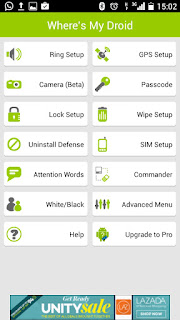Things you will need:
1. Sim
card with free data (doesn’t have to be broadband)
2. Phone
(preferable Samsung because they are rated for the best GPS locking) S3s or
notes are cheap now
3. In
car charger
4. 12v
timer (optional)
5. Where’s
my droid tracking software (https://play.google.com/store/apps/details?id=com.alienmanfc6.wheresmyandroid&hl=en)
6. Auto
Answer software (https://play.google.com/store/apps/details?id=com.mathalogic.autoanswer&hl=en)
Step 1:
Insert the sim card into the phone and make sure you set
it up to have internet access
Step 2:
Ensure the following settings are done:
1. Silent
and no vibration mode
2. GPS
always turned on
3. Set
the screen lock to pin number
Step 3:
Install the software and configure them:
1. Where’s
My Droid
a. Follow
the setup instructions and be sure to setup an account for the commander
2. Auto
Answer Software
a. Set
to enabled
b. Answer
calls from only starred (ensure you star your own number and a few trusted
friends.)
c. Delay
before answer 2 seconds
d. Force
speakerphone OFF
WHY:
Where’s my droid is a free tracking software that you can
login to your account via the internet or via your phone. The idea is to track
your phone which will be hidden in your vehicle. Its free unless you want to
pay for upgrades which is cool.
Your GPS locking now is smart enough to triangulate your position
via cell towers around you if there is no GPS tracking available at the time
(in door or cloudy). That’s why you must ensure your internet connectivity is
set up correctly.
Samsung devices (especially S3, Note 1 and up) have very
fast GPS locking and lock on to more GPS satellites than other brands.
Auto answer software (this specific one and many others)
are free and allow you to monitor the situation if you suspect your vehicle is
stolen. This is more likely to be used if the device is in a car.
Step 4:
Locate a good place to hide your phone!
It must meet these categories:
1. Dry
place (unless you seal it in a sandwich bag)
2. Not
surrounded by metal (under a gas tank or anything like that) this dramatically
reduces reception.
3. Somewhere
not obvious first place ppl will look:
a. Car:
i.
Inside your dashboard
ii.
Under your seat
iii.
In your glove compartment
iv.
Under the hood
b. Bike:
i.
Under your seat
ii.
Behind your headlamp
iii.
In your saddle bags
Step 5:
Wire shit up
1. Disassemble
the cigarette lighter usb charger.
2. Extend
the red and black wires as long as you need them.
3. Connect
the red to the positive terminal of your battery and the black to the negative
terminal of your battery.
4. Additional:
you may connect a 12v timer if you don’t want to keep juicing your phone for no
reason. Wire the timer to the battery then connect the charger to the positive
and negative terminal to the timer. Suggested charge times would be 2-4 hours
every 12 hour intervals.
Step 6:
Test your stuff
Sms the command to your phone and wait for the location.
Step 7:
Button everything up
Where's My Droid
Auto Answer
Disassembled Charger
Results of Location Search
By Vy





















